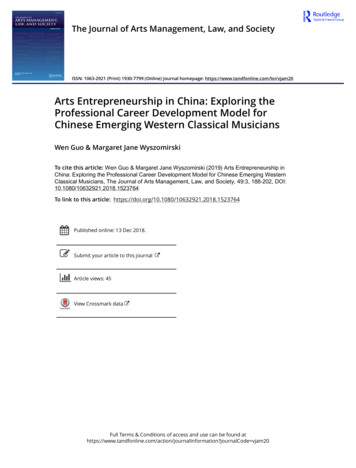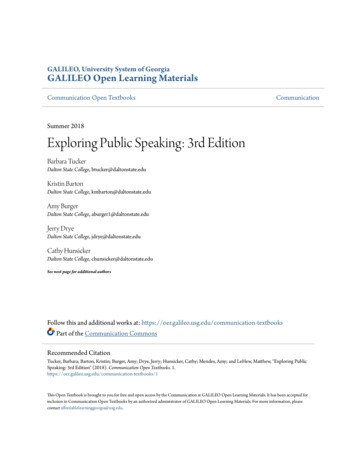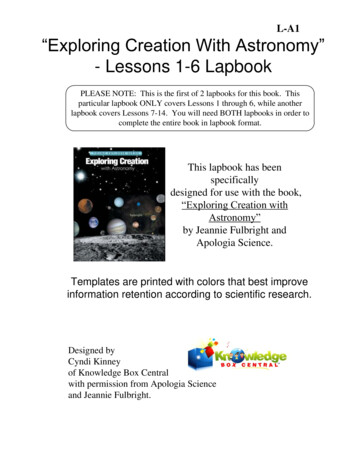
Transcription
TECHNICAL WHITE PAPERExploring the Depth of Simplicity:Protecting Microsoft SQL Server with Rubrik
Released March 2017TABLE OF CONTENTSAUDIENCE.3EXECUTIVE SUMMARY.3COMMON CUSTOMER CHALLENGES.3OVERVIEWS. 4Capability Overview.4Setup Overview.4SLA Domain Policy Overview.5Configuration & Restore Overview.7DEEP DIVE.10Incremental Forever Snapshots. 10Granular Database Protection. 10Point-In-Time Restores. 11Restore User - Role Based Access Control. 11Simple Configuration. 12Transparent Connector Upgrades. 12Auto-Discovery. 12Centralized Management. 12Encrypted Database Support. 13Flash Optimized Parallel Ingest. 13Flexibility to protect SQL at a VMware level. 13SQL DATABASE RECOVERY OPTIONS. 13ADVANCED SQL FUNCTIONALITY SUPPORT. 13Always On. 13Windows Server Failover Clustering (WSFC) with SQL Server. 13Cross Version Restore. 14Recovery to a Specific LSN via the API. 14UNDER THE HOOD. 15SQL Backup Flow. 15SQL Restore Flow. 15CONCLUSION. 15TECHNICAL WHITE PAPER PROTECTING MICROSOFT SQL SERVER WITH RUBRIK
AUDIENCEThis white paper is intended for backup administrators and DBA’s to provide a deep dive around theimplementation and benefits of Rubrik’s support for Microsoft SQL Server backups.Note: for the remainder of this white paper, we will simply refer to “SQL Server” to be concise rather than“Microsoft SQL Server”, “SQL”, or “MS SQL”.EXECUTIVE SUMMARYMany organizations use Microsoft SQL Server for their critical applications. Throughout the years SQL Serverhas steadily improved to become a critical component of modern datacenters. Despite these improvements,SQL Server backups have often been a question of trade-offs between cost, efficiency, and simplicity.Rubrik’s SQL Server backup functionality builds on top of Rubrik’s policy-driven architecture extending it toSQL backups. Although SQL Server environments can be complex, Rubrik’s support for SQL Server backupsaligns with the core architectural and operational simplicity of the Rubrik platform.For a walkthrough of Rubrik architecture, see the “Technology Overview & How It Works” white paper.COMMON CUSTOMER CHALLENGESIn creating Rubrik’s SQL support, we discussed with our customers what challenges they were seeing andincorporated those into our design goals. We heard.TECHNICAL WHITE PAPER PROTECTING MICROSOFT SQL SERVER WITH RUBRIK3
OVERVIEWSCAPABILITY OVERVIEWAligning with the challenges we heard from customers, the key benefits of our approach are: Auto-discovery of all instances, databases, and clusters on each SQL Server lowering operationaloverhead during configuration Centralized management via visibility in the Rubrik UI of all databases both being backed up as well asexcluded from backup “Incremental-forever” backups via block mapping and intelligent transaction log handling todramatically reduce local storage requirements, provide much faster backups, and reduce networkusage Granular database protection via Rubrik SLA policies - ability to have different policies at the serverand instance level as well per database on the same SQL Server or instance Seamless point-in-time restore via a very simple, efficient interface providing full-backup restores transaction log replay via a single operation Log truncation and log management providing further operational time savings Copy-only mode for seamless transition or coexistence with existing backup product Full application awareness in high availability deployments like Always On Availability Groups andWindows Failover Cluster.We’ll explore these and more in the feature Deep Dive below.SETUP OVERVIEWRubrik supports all versions of SQL supported by Microsoft via Extended Support - Windows Server 2008 R2and newer with SQL Server 2008 and newer. Please see the Rubrik Compatibility Matrix for supported versiondetails. Per Microsoft, Extended Support for SQL Server 2005 ended in April 2016.To provide integrated SQL functionality, Rubrik uses a lightweight SQL Connector which uses minimal CPU andStorage. The connector encrypts all backup traffic. As an MSI, it can be installed manually or easily deployed viastandard provisioning tools. The connector does not require changing existing maintenance plans or rebuildingthem from scratch.To reduce operational overhead, connector upgrades after installation are automatic and completelytransparent to the user.Once the connector is installed, SQL databases are automatically discovered. The user can assign policies tothe individual databases – these policies are core to Rubrik and can be leveraged across multiple data types.TECHNICAL WHITE PAPER PROTECTING MICROSOFT SQL SERVER WITH RUBRIK4
SLA DOMAIN POLICY OVERVIEWA Rubrik SLA Domain Policy is a declarative policy encompassing the core items needed for backup andrecovery replacing the need to individually configure jobs, tasks, and other items. SLA Domain Policies are acore part of Rubrik’s architecture which extend across all data types as shown here.Figure 1: Rubrik Policy OverviewLet’s walk through the pieces needed to configure an SLA Domain Policy that can apply to all data types we’ll look at SQL specific items in the next section.1. Backup Frequency: this is also known as Recovery Point Objective (RPO). Simply put, how often arebackups are taken? For databases, this determines how often a database restore point is synthesized from incrementallytransmitted block maps. For databases in Full Recovery mode, RPO is also impacted by the frequencyof transaction log backups.2. Availability Duration: this is also known as retention. Simply put, how long are backups retained? For databases, retention may often be shorter than other data types unless needed for regulatory orcompliance reasons.Figure 2: Rubrik Policy Components - Frequency and DurationTECHNICAL WHITE PAPER PROTECTING MICROSOFT SQL SERVER WITH RUBRIK5
Archival Policy: this is also known Recovery Time Objective (RTO) or “When and Where to Archive”.Archive targets can be public cloud (AWS or Azure) or private cloud (S3 compatible object stores orNFS). This dictates which cloud target is used for archive and when archives are maintained solely in thecloud and not on the local Rubrik cluster. If archives are maintained solely in the cloud (past 30 days forinstance), RTO is longer due to the time required to retrieve back to the Rubrik cluster.3. For databases, long-term archive required for regulatory or compliance reasons can be stored in acloud archive.Figure 3: Rubrik Policy Components - ArchivalReplication Policy: this relates to Disaster Recovery. Simply put, how much replicated data should bemaintained at a DR site?4. For databases, this will often be a shorter value. In a Disaster Recovery situation, recovery of the mostrecent state of a database is most common. This policy section allows cost savings by storing a recentsubset of data at a DR site.Figure 4: Rubrik Policy Components - ReplicationThe policy architecture is intentionally straightforward to configure yet powerful - the screenshots aboveillustrate the concepts well. Please see Rubrik documentation and the core architecture white paper for a morethorough walkthrough of SLA Domain details.TECHNICAL WHITE PAPER PROTECTING MICROSOFT SQL SERVER WITH RUBRIK6
CONFIGURATION & RESTORE OVERVIEWAs noted above, SLA Domain Policies can be applied at the SQL server, instance, database, or cluster level.A visual walkthrough illustrates the concepts well along with illustrating the notably few SQL specificconfiguration options.A list of auto-discovered SQL inventory at the server and database level - instance level is also available.Figure 5: SQL Inventory - Server LevelFigure 6: SQL Inventory - Database LevelTECHNICAL WHITE PAPER PROTECTING MICROSOFT SQL SERVER WITH RUBRIK7
After selecting a server, instance, or database, clicking the “Manage Protection” button brings up the policyassignment screen where can assign a policy as well as set options around copy only backups, log backupfrequency, and log backup retention.Figure 7: SQL Policy ManagementFigure 8: SQL Policy ManagementTECHNICAL WHITE PAPER PROTECTING MICROSOFT SQL SERVER WITH RUBRIK8
Once protected, the restore process is a simple slider for point-in-time restore.Figure 9: Point in Time Restore ControlTECHNICAL WHITE PAPER PROTECTING MICROSOFT SQL SERVER WITH RUBRIK9
DEEP DIVELet’s explore in depth at a feature by feature level the items discussed briefly in the overview above. Many ofthe features explored below are intentionally transparent during day to day operations.INCREMENTAL FOREVER SNAPSHOTSIncremental Forever snapshots dramatically reduce storage usage as well as network traffic both inside thedatacenter as well as over replication links. Although SQL Server does not natively support incremental-foreverbackups, Rubrik can provide this capability via block mapping.Databases using Full recovery model can be protected through policy driven snapshots and backups of thetransaction log, or through policy driven snapshots only. The Rubrik cluster performs an initial full databasebackup followed by periodic block mapping to detect and transmit changed data based on the assignedpolicy. Additionally, there are frequent interim backups of the transaction log with ability to specify the defaultfrequency transaction log backups as well as retention of transaction log backups.Figure 10: SQL Specific Policy OptionsThe combination of database snapshots and transaction log backups permits granular restore of a database toa specified recovery point. See the “Advanced SQL Functionality” section below for details on the “Recovery toa Specific LSN via the API” feature. During backups, transaction logs can be either truncated or left untouchedvia a “Copy Only” mode - a checkbox option available during SLA assignment.For databases using Simple recovery model, the Rubrik cluster performs policy driven snapshots of thedatabase similar to the approach outlined above.GRANULAR DATABASE PROTECTIONProtection policies can be assigned at the Windows host level, an entire SQL instance, any individual database,and even multiple overlapping levels - the most granular assignment has priority. Derived assignment providesa way to uniformly manage and protect those databases however only applies to the databases that existat the time of the assignment. This provides flexibility on SQL servers hosting many databases for differentpurposes - some of which may have more stringent RPO and RTO requirements than others.Rubrik can easily assign unique policies to individual databases.See the “SLA Domains” column in the screenshot below as an example.Figure 11: SLA DomainsTECHNICAL WHITE PAPER PROTECTING MICROSOFT SQL SERVER WITH RUBRIK10
POINT-IN-TIME RESTORESSQL Databases often support critical workloads which require an RPO in minutes. Rubrik achieves this bybacking up the transaction logs in addition to the databases. During the restore process, a user specifies adesired restore time simply by choosing a day and dragging a slider to the desired time. Alternately, a specifictime can be typed in. The system then performs the following steps: Restores the full snapshot closest to the user specified time Replays and applies transactions starting from the point of snapshot to the time specified by the user.This is often known as “rolling transaction logs”.While the amount of time needed to restore is dependent on multiple variables (network speed, primarystorage, and more), the time for replaying transaction logs can be reduced by specifying more full snapshots something configurable via Rubrik policy.Figure 12: Point in Time Restore ControlsFigure 13: Role Based Access ControlRESTORE USER - ROLE BASED ACCESS CONTROLRestores can be performed either by a Rubrik administrator or viathe “End User” role - a role that is assigned granular per objectpermissions on creation to perform restores. Users with this role canspecifically be granted permission to perform in-place “DestructiveRestores” which will overwrite existing data. Alternatively, the EndUser role can Export to a new location as described below.TECHNICAL WHITE PAPER PROTECTING MICROSOFT SQL SERVER WITH RUBRIK11
SIMPLE CONFIGURATIONThere is no job configuration and no requirement for a staging server - simply the Rubrik cluster and SQLservers with the connector installed.TRANSPARENT CONNECTOR UPGRADESIn larger environments, upgrading backup agents with new versions can be time-consuming and often delaybackup environment upgrades due to time required for agent updates.Rubrik’s ability to automatically and transparently upgrade its SQL connector removes the time needed formanual agent updates. We have done this via an inner and outer core design - the outer core detects softwareupgrades and upgrades the inner core connector. The connector upgrade does not require a restart of SQLServer or the underlying Windows host.AUTO-DISCOVERYRubrik auto-discovers all instances and databases on each SQL server where the connector is installed. Multipleviews are then provided which are easily sortable and searchable - Hosts/Instances, All DBs, and Failover Clusters.Figure 14: Auto-Discovery of all databasesCENTRALIZED MANAGEMENTAlthough an overused term, Rubrik does provide a “single pane of glass” for all supported backup workloads.For SQL specifically, Rubrik customers can see all backed up SQL servers, instances, and databases in a singleinterface. The same UI and the same policy engine is used whether for SQL, VMware, Linux, or Windows.This does not preclude the ability for DBA’s to verify backup success from SQL Server Management Studio viaquerying the “backup set” table in the “msdb” database which records all successful backups. See this link onMSDN for further details. As well, a full walkthrough of this process is available as a KnowledgeBase article inthe Rubrik Support Portal.TECHNICAL WHITE PAPER PROTECTING MICROSOFT SQL SERVER WITH RUBRIK12
ENCRYPTED DATABASE SUPPORTRubrik will backup encrypted databases and fingerprint-based compression will also work on encrypteddatabases. For restore, the workflows are the same with one additional step - users must manage keysmanually. Steps required to move keys are detailed in this Microsoft article. Once this is done, the intendeddatabase can be exported from the Rubrik UI.FLASH OPTIMIZED PARALLEL INGESTAlthough a core Rubrik capability, flash optimized parallel ingest is particularly relevant for large databasebackups. Backups are taken in parallel across multiple nodes due to Rubrik’s distributed job scheduling andland on flash before destaging to disk. This removes bottlenecks during large initial backups and allows fasterprotection.FLEXIBILITY TO PROTECT SQL AT A VMWARE LEVELIn a virtualized environment using Simple Recovery Mode, Rubrik’s enhanced VMware backup capabilities maybe sufficient with even lower operational overhead. While this does not include many of the specific benefitslisted in this paper, it does provide backup consistency via Rubrik’s VSS implementation, Instant Recovery viaLive Mount, and Object Level Recovery using Kroll. For databases in simple recovery mode, this may meetor exceed business requirements. This approach notably does not provide Point In Time Restore, GranularDatabase Protection, and Log Management.SQL DATABASE RECOVERY OPTIONSThere are two recovery options for SQL Databases - Restore and Export.Choosing Restore drops the original database and creates a new database on the same instance with the samename and file structure. A common use case for this option is corruption of the original database where arestore to a previous “point in time” is desired.Choosing Export creates a new database. If restoring to the same SQL instance, a different database nameis used with file structure reflecting that name. If to a different SQL instance, the same or different databasename can be used. A common use case for this option is use a production database snapshot as the source tospin up a dev/test clone.Given SQL Server’s capability for a database to have multiple data and log files, customers can now specify atan individual file level the restore location during an Export operation.ADVANCED SQL FUNCTIONALITY SUPPORTALWAYS ONAlways On is a high availability solution provided by SQL Server. Additional details are available from Microsoftin Overview of Always On Availability Groups (SQL Server).Rubrik will automatically detect if databases are part of an Availability Group and not “double backup” thesame database located on multiple servers in the same Availability Group. In the case of Always On failover,simply switch protection to the new database with no loss of history and no need for a new full backup.TECHNICAL WHITE
The connector encrypts all backup traffic. As an MSI, it can be installed manually or easily deployed via . A Rubrik SLA Domain Policy is a declarative policy encompassing the core items needed for backup and recovery










